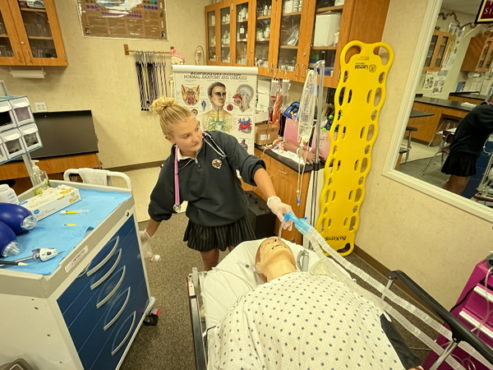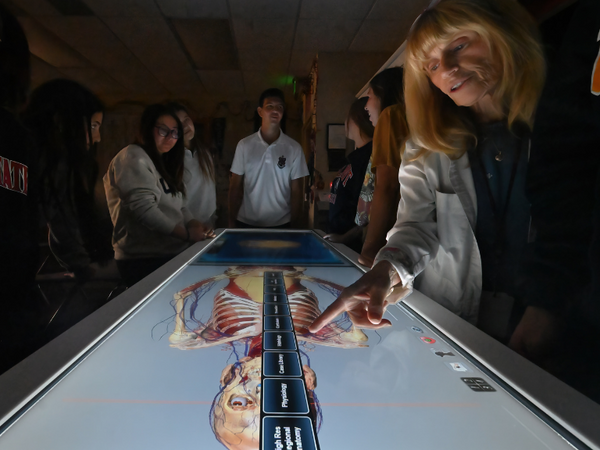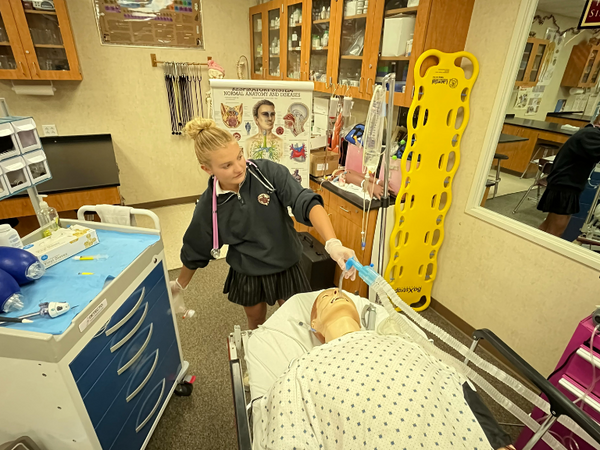Like doctors gathered around a patient, a dozen students from Betty Cappelletti’s Medical Magnet Program at JSerra Catholic High recently assembled around a seven-foot table.

CAROLINE LORBER, A SOPHOMORE AT JSERRA IN THE SCHOOL’S MEDICAL MAGNET PROGRAM, DEMONSTRATES HOW TO INTUBATE WALDO, ONE OF THE PROGRAM’S LEADING EDGE EQUIPMENT. COURTESY OF JSERRA CATHOLIC HIGH SCHOOL
On the table, or, rather, within, lay a three-dimension, life-size representation of an actual male cadaver. By hitting a few buttons, students could examine the underlying skeleton, organs, veins and nervous system. Other options allowed them to zoom in on specific body areas, pull them out and rotate to observe from any angle.
This is just one of a number of cutting-edge technological and teaching tools available to students in the program.
Combined with a passionate teacher in Cappelletti, who started the program 12 years ago, a number of graduates have advanced into the medical field. The program is trademarked Project A-Pulse and has a copyrighted curriculum, textbooks and instructional methods.
Carlos Solorzano Jr., a 2013 graduate of JSerra, started taking classes with Cappelletti with freshman biology, when she was just putting together the medical magnet program. He is the first of her students to carry his studies all the way into residency.
After graduating from USC and UCLA, Solorzano recently received his match for residency in orthopedic surgery at Harbor-UCLA Medical Center. Going into high school, where he played soccer, football and baseball, Solorzano said his focus was on athletics. But being introduced to medical sciences through the magnet program changed things.
“When I saw the layout and trajectory of my life, I switched gears from athletics,” he said. “I saw what I could be happy doing for 40 or 50 years.”
It was Cappelletti’s anatomy class, especially dissections, that flipped the switch.
“That’s what sparked my interest,” he said. “Those experiences turned me toward surgery.”
A living example
Cappelletti, 68, grew up in tough economic circumstances. Her father died of heart disease when she was young. Her mother raised the family as a single wage earner and Cappelletti supported herself through school. The challenges she faced as a student are reflected in her desire to ensure that her kids have top-of-the-line instruction, not only to prepare them for advanced degrees in medicine but imbue them with the passion she feels.
“I am just the spark to the flame that carries them where they want to go.” she said.
Cappelletti was appointed to JSerra in 2005. She holds numerous certifications, bachelor and master’s degrees and in 2016 earned a doctorate in health sciences.
That’s why when she talks about being a life-long learner, it’s not just by words but it is backed by her actions. The medical magnet requires students to be enrolled in advanced science and math classes and maintain a weighted GPA of 3.75 and a 95% school attendance.
As seniors, students are able to take advanced classes in genetics and neuroscience not offered in many high schools. In addition, students spend two years shadowing doctors in a hospital setting and gain first-hand insight into medical practice.
“This program is relatively unique,” Solorzano said.
But he said even for those who don’t follow the medical path, the heavy emphasis on math and science pays dividends in college.
Caroline Lorber is a sophomore who said medicine has a lifelong fascination passed on by her grandfather, a rheumatologist. Unlike the rest of the grandkids, she said, she loved listening to him.
“I’m indecisive, but I know this is something I will stay with,” Lorber said of medicine.
In addition to the 3-D table, the classroom is stuffed with top-of-the-line equipment and teaching aids.
One is Waldo, a 6-foot, 200-pound medical mannequin, or simulated man. Linked to a computer, he can be programmed to respond to questions, breathe, sleep and awaken.
Through his years at JSerra, Waldo has been poked and prodded, intubated and catheterized. He has been subjected to asthma attacks and heart ailments.
“He has had a lot of tubes stuck down his throat,” said Lorber, as she demonstrated the proper way to intubate a patient.
By listening to Waldo’s heart and lungs, students learn to identify and analyze a number of potential ailments.
Cappelletti said her students leave SimRated by UC Irvine and certified to perform five clinical procedures ranging from suturing to inserting intravenous catheters.
Bringing faith into class Cappelletti said faith is an important part of her instruction, although she does not force Catholic beliefs on her students. She teaches an ethics class which she says is vital.
In it, students review controversial medical case studies and their implications morally and medically.
Then they must debate treatment on both sides. Cappelletti believes in the corporal works of mercy: giving food, drink, shelter, visiting the imprisoned and sick and alms for the poor. She says the students’ in-hospital experiences allow them to see the values played out.
“You see religion in practice every day in the hospital,” she said. “The sacrifice of people giving themselves to those in need, the ethics of respect of life.”
Every Monday and Friday as class ends, Cappelletti gathers students for a favorite prayer, “Guardian Angel,” to protect them. As school was about to be dismissed, she recited it for the class.
“Angel of God, my guardian dear,
To whom God’s love commits me here,
Ever this day, be at my side,
To light and guard,
To rule and guide. Amen.”


